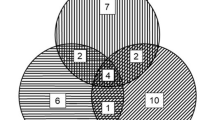Abstract
Bacillus thuringiensis is a bacterium best known for its production of crystal-like bodies comprised of one or more Cry-proteins, which can be toxic to insects, nematodes or cancer cells. Although strains of B. thuringiensis have occasionally been observed with filamentous appendages attached to their spores, appendages in association with their parasporal bodies are extremely rare. Herein we report the characterization of Bt1-88, a bacterial strain isolated from the Caribbean that produces a spore–crystal complex containing six long appendages, each comprised of numerous thinner filaments approximately 10 nm in diameter and 2.5 μm in length. Each of the multi-filament appendages was attached to a single, small parasporal body located at one end of the bacterial spore. Biochemical tests, 16S rDNA gene sequencing, and the identification of two Cry proteins by partial protein sequencing (putatively Cry1A and Cry2A), unambiguously identified Bt1-88 as a strain of B. thuringiensis. Bt1-88 represents the second reported strain of B. thuringiensis possessing a parasporal body/appendage phenotype characterized by one or more long appendages, comprised of numerous filaments in association with a parasporal body. This finding suggests that Bt1-88 is a member of a new phenotypic class of B. thuringiensis, in which the parasporal body may perform a novel structural role through its association with multi-filament appendages.




Similar content being viewed by others
References
Chaufax J, Marchal M, Gilois N, Jehanno I, Buisson C (1997) Investigation of natural strains of Bacillus thuringiensis in different biotypes throughout the world. Can J Microbiol 43:337–343
Crickmore N, Zeigler DR, Feitelson J, Schnepf E, Van Rie J, Lereclus D, Baum J, Dean DH (1998) Revision of the nomenclature for the Bacillus thuringiensis pesticidal crystal proteins. Microbiol Mol Biol Rev 62:807–813
Akiba T, Abe Y, Kitada S, Kusaka Y, Ito A, Ichimatsu T, Katayama H, Akao T, Higuchi K, Mizuki E, Ohba M, Kanai R, Harata K (2009) Crystal structure of the parasporin-2 Bacillus thuringiensis toxin that recognizes cancer cells. J Mol Biol 386:121–133
Rampersad J, Khan A, Ammons D (2003) A Bacillus thuringiensis isolate possessing a spore-associated filament. Curr Microbiol 47:355–357
Smirnova TA, Kulinich LI, Galperin MY, Azizbekyan RR (1991) Subspecies-specific haemagglutination patterns of fimbriated Bacillus thuringiensis spores. FEMS Microbiol Lett 90:1–4
DesRosier JP, Lara JC (1981) Isolation and properties of pilli from spores of Bacillus cereus. J Bacteriol 146:613–619
Mizuki E, Ohba M, Ichimatsu T, Hwang SH, Higuchi K, Saitoh H, Akao T (1998) Unique appendages associated with spores of Bacillus cereus. J Basic Microbiol 38:33–39
Sthalteim T, Granum PE (2001) Characterization of spore appendages from Bacillus cereus strains. J Appl Microbiol 91:839–845
Rode LJ, Crawford MA, Williams MG (1967) Clostridium spores with ribbon-like appendages. J Bacteriol 93:1160–1173
Pope L, Yolton DP, Rode LJ (1967) Appendages of Clostridium bifermentans spores. J Bacteriol 94:1206–1215
Pope L, Rode LJ (1969) Spore fine structure in Clostridium cochlearium. J Bacteriol 100:994–1001
Samsonoff WA, Hashimoto T, Conti SF (1970) Ultrastructural changes associated with germination and outgrowth of an appendage-bearing clostridial spore. J Bacteriol 101:1038–1045
Rampersad J, Ammons D (2005) A Bacillus thuringiensis isolation method utilizing a novel stain, low selection and high throughput produced atypical results. BMC Microbiol 5:52–62
Reyes A, Ibarra JE (2004) Fingerprinting of Bacillus thuringiensis type strains and isolates by using Bacillus cereus group-group repetitive extragenic palindromic sequence-based PCR analysis. Appl Environ Microbiol 71:1346–1355
Heddi A, Grennier AM, Khatchadourian C, Charles H, Nardon P (1999) Four intracellular genomes direct weevil biology: nuclear, mitochondrial, principal endosymbiont, and wolbachia. Evolution 96:6814–6819
Hall TA (1999) BioEdit: a user-friendly biological sequence alignment editor and analysis program for Windows 95/98/NT. Nucleic Acids Symp Ser 41:95–98
Tamura K, Dudley J, Nei MK (2007) MEGA4: molecular evolutionary genetics analysis (MEGA) software version 4.0. Mol Biol Evol 24:1596–1599
Thompson JD, Higgins DG, Gibson TJ, Clustal W (1994) Improving the sensitivity of progressive multiple sequence alignment through sequence weighting, position-specific gap penalties and weight matrix choice. Nucleic Acids Res 22:4673–4680
Saitou N, Nei M (1987) The neighbor-joining method: a new method for reconstructing phylogenetic trees. Mol Biol Evol 4:406–425
Felsenstein J (1985) Confidence limits on phylogenies: an approach using the bootstrap. Evolution 39:783–789
Altschul SF, Gish W, Miller W, Myers EW, Lipman DJ (1990) Basic local alignment search tool. J Mol Biol 215:403–410
Laemmli JK, Favre M (1973) Maturation of the head of bacteriophage T4 I. DNA packing agents. J Mol Biol 80:575–599
Reynolds ES (1963) The use of lead citrate at a high pH as electron-opaque stain in electron microscopy. J Cell Biol 17:208–212
Rampersad J (2006) A study on the isolation of Bacillus thuringiensis from the environment: a critical look at library construction. PhD thesis, The University of the West Indies, Trinidad and Tobago
Acknowledgments
LIRA and RCC thanks financial support for this research, from Secretaría de Investigación y Posgrado, Instituto Politécnico Nacional, through grants SIP 20070722, SIP 20082599 and SIP 20090912. AVS was supported by scholarships from CONACYT and PIFI. LIRA and RCC are recipients of CONACYT, COFAA and EDI fellowships. JNR thanks the Faculty Research Council at the University of Texas- Pan American for financial support of work described in this Report. We would like to acknowledge the technical assistance of Dr. Klaus Linse, University of Texas, Austin, in performing N-terminal protein sequencing.
Author information
Authors and Affiliations
Corresponding author
Rights and permissions
About this article
Cite this article
Ventura-Suárez, A., Cruz-Camarillo, R., Rampersad, J. et al. Characterization of a Novel Bacillus thuringiensis Phenotype Possessing Multiple Appendages Attached to a Parasporal Body. Curr Microbiol 62, 307–312 (2011). https://doi.org/10.1007/s00284-010-9678-2
Received:
Accepted:
Published:
Issue Date:
DOI: https://doi.org/10.1007/s00284-010-9678-2




